- «Polka Dots and Moonbeams» Sheet Music
- James Van Heusen, Jimmy Van Heusen
- Top Sellers
- «Polka Dots and Moonbeams» Sheet music for Piano
- Polka Dots and Moonbeams
- composed by James Van Heusen
- Polka Dots and Moonbeams
- composed by James Van Heusen
- Polka Dots and Moonbeams
- composed by Jimmy Van Heusen
- Polka Dots and Moonbeams
- composed by Jimmy Van Heusen
- Polka Dots and Moonbeams
- by Bob Dylan
- «Polka Dots and Moonbeams» Sheet music for Voice
- Polka Dots and Moonbeams
- composed by James Van Heusen
- Polka Dots and Moonbeams
- composed by James Van Heusen
- Polka Dots and Moonbeams
- composed by Jimmy Van Heusen
- Polka Dots and Moonbeams
- composed by Jimmy Van Heusen
- Polka Dots and Moonbeams
- composed by Jimmy Van Heusen
- Polka Dots and Moonbeams
- by Bob Dylan
- «Polka Dots and Moonbeams» Sheet music for Guitar
- Polka Dots and Moonbeams
- composed by Jimmy Van Heusen
- Polka Dots and Moonbeams
- by Bob Dylan
- «Polka Dots and Moonbeams» Sheet music for C Instrument
- Polka Dots and Moonbeams
- composed by Jimmy Van Heusen
- «Polka Dots and Moonbeams» Sheet music for Treble Clef Instrument
- Polka Dots and Moonbeams
- composed by Jimmy Van Heusen
- Wes Montgomery — Polka Dots And Moonbeams табулатура и аккорды ДЕМО-ВЕРСИЯ
- Не можете найти нужную табулатуру?
- Не можете найти нужную табулатуру?
- Polka dots and moonbeams ноты
«Polka Dots and Moonbeams» Sheet Music
James Van Heusen, Jimmy Van Heusen
Browse our 7 arrangements of «Polka Dots and Moonbeams.» Sheet music is available for Piano, Voice, Guitar and 2 others with 5 scorings and 1 notation in 5 genres. Find your perfect arrangement and access a variety of transpositions so you can print and play instantly, anywhere.
Lyrics begin: «A country dance was being held in a garden.»
Top Sellers
«Polka Dots and Moonbeams»
Sheet music for Piano
Polka Dots and Moonbeams
composed by James Van Heusen
Scoring: Piano/Vocal/Chords
Instruments: Piano, Voice
Pages: 4
Product Type: Digital Sheet Music
Polka Dots and Moonbeams
composed by James Van Heusen
Scoring: Instrumental Solo
Instruments: Piano
Pages: 3
Product Type: Digital Sheet Music
Polka Dots and Moonbeams
composed by Jimmy Van Heusen
Scoring: Piano/Vocal/Guitar
Instruments: Guitar, Piano, Voice
Pages: 5
Lyrics: Contains complete lyrics
Product Type: Digital Sheet Music
Polka Dots and Moonbeams
composed by Jimmy Van Heusen
Scoring: Piano/Vocal/Chords
Notation: Beginner Notes
Instruments: Piano, Voice, Treble Clef Instrument
Pages: 2
Lyrics: Contains complete lyrics
Product Type: Digital Sheet Music
Polka Dots and Moonbeams
by Bob Dylan
Scoring: Piano/Vocal/Guitar
Instruments: Guitar, Piano, Voice
Pages: 5
Lyrics: Contains complete lyrics
Product Type: Digital Sheet Music
«Polka Dots and Moonbeams»
Sheet music for Voice
Polka Dots and Moonbeams
composed by James Van Heusen
Scoring: Leadsheet
Instruments: Voice
Pages: 2
Product Type: Digital Sheet Music
Polka Dots and Moonbeams
composed by James Van Heusen
Scoring: Piano/Vocal/Chords
Instruments: Piano, Voice
Pages: 4
Product Type: Digital Sheet Music
Polka Dots and Moonbeams
composed by Jimmy Van Heusen
Scoring: Leadsheet, Lyrics/Melody/Chords
Instruments: Voice, C Instrument
Pages: 3
Lyrics: Contains complete lyrics
Product Type: Digital Sheet Music
Polka Dots and Moonbeams
composed by Jimmy Van Heusen
Scoring: Piano/Vocal/Guitar
Instruments: Guitar, Piano, Voice
Pages: 5
Lyrics: Contains complete lyrics
Product Type: Digital Sheet Music
Polka Dots and Moonbeams
composed by Jimmy Van Heusen
Scoring: Piano/Vocal/Chords
Notation: Beginner Notes
Instruments: Piano, Voice, Treble Clef Instrument
Pages: 2
Lyrics: Contains complete lyrics
Product Type: Digital Sheet Music
Polka Dots and Moonbeams
by Bob Dylan
Scoring: Piano/Vocal/Guitar
Instruments: Guitar, Piano, Voice
Pages: 5
Lyrics: Contains complete lyrics
Product Type: Digital Sheet Music
«Polka Dots and Moonbeams»
Sheet music for Guitar
Polka Dots and Moonbeams
composed by Jimmy Van Heusen
Scoring: Piano/Vocal/Guitar
Instruments: Guitar, Piano, Voice
Pages: 5
Lyrics: Contains complete lyrics
Product Type: Digital Sheet Music
Polka Dots and Moonbeams
by Bob Dylan
Scoring: Piano/Vocal/Guitar
Instruments: Guitar, Piano, Voice
Pages: 5
Lyrics: Contains complete lyrics
Product Type: Digital Sheet Music
«Polka Dots and Moonbeams»
Sheet music for C Instrument
Polka Dots and Moonbeams
composed by Jimmy Van Heusen
Scoring: Leadsheet, Lyrics/Melody/Chords
Instruments: Voice, C Instrument
Pages: 3
Lyrics: Contains complete lyrics
Product Type: Digital Sheet Music
«Polka Dots and Moonbeams»
Sheet music for Treble Clef Instrument
Polka Dots and Moonbeams
composed by Jimmy Van Heusen
Scoring: Piano/Vocal/Chords
Notation: Beginner Notes
Instruments: Piano, Voice, Treble Clef Instrument
Pages: 2
Lyrics: Contains complete lyrics
Product Type: Digital Sheet Music
Источник
Wes Montgomery — Polka Dots And Moonbeams табулатура и аккорды ДЕМО-ВЕРСИЯ
jazz jazz guitar guitar 5 Просмотров 986 Скачать табулатуру
- 200%
- 190%
- 180%
- 170%
- 160%
- 150%
- 140%
- 130%
- 120%
- 110%
- 100%
- 90%
- 80%
- 70%
- 60%
- 50%
Мы выбрали лучшие табы (ноты) Wes Montgomery — Polka Dots And Moonbeams, из тех, что находились на просторах сети. Надеемся, они помогут вам в успешном изучении этой популярной композиции.
Лучший способ научиться играть песню Wes Montgomery — Polka Dots And Moonbeams на гитаре. Проигрывайте табулатуру и аккорды прямо в вашем браузере без каких-либо дополнительных программ!
Не можете найти
нужную табулатуру?
Сделайте запрос и мы добавим ее в базу в ближайшее время
Не можете найти
нужную табулатуру?
Сделайте запрос и мы добавим ее в базу в ближайшее время
© 2013 — 2020 StarTabs. Все права защищены.
Наш проект дает возможность проигрывать гитарные табулатуры прямо в вашем браузере. Пожалуй лучший и самый быстрый способ разучивания песен без помощи вспомогательных программ.
Источник
Polka dots and moonbeams ноты
Copyright 2005-2020 — JazzStandards.com
All Rights Reserved
Permission & contact information
| |||||||||||||||||||||||||||||||||||||||||||||||||||||||||
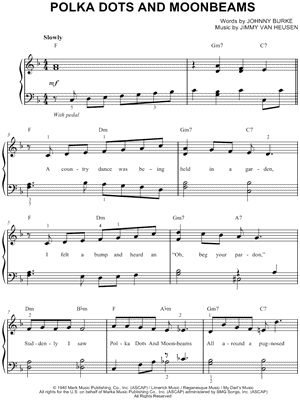
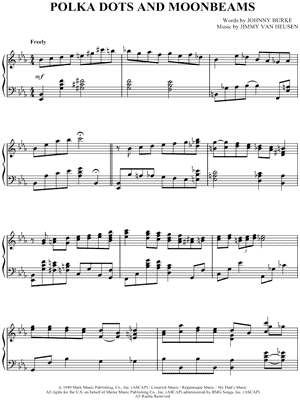
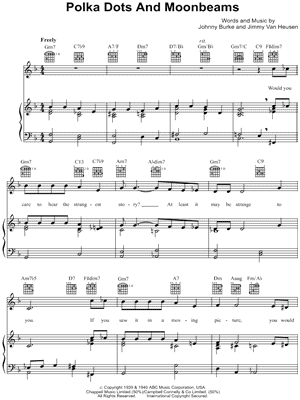
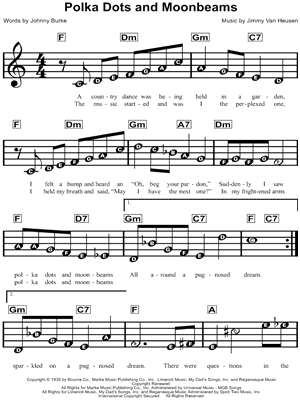
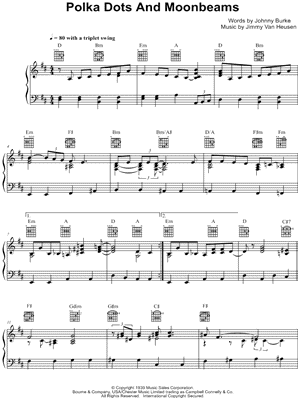
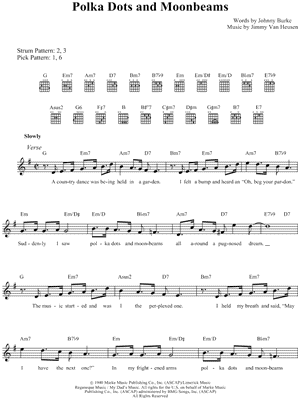
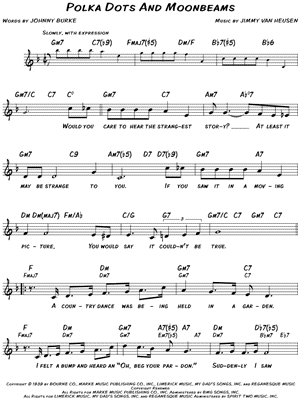











 Robert Gottlieb, Robert Kimball
Robert Gottlieb, Robert Kimball  Gil Evans
Gil Evans 
 Donald Byrd and Doug Watkins
Donald Byrd and Doug Watkins 
 Elmo Hope
Elmo Hope  Alec Wilder
Alec Wilder  Thomas S. Hischak
Thomas S. Hischak